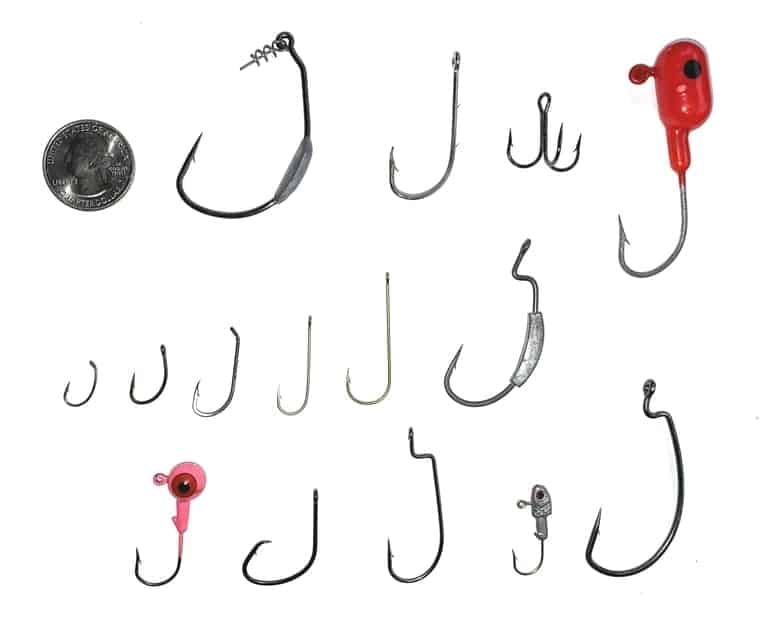
Wondering what fishing hook sizes you should buy for your next trip? Tired of all the confusing terminology from hook manufacturers? Confused about which style of hook to use for a certain type of fish?
Don’t worry- you’re not alone. In fact, even the most experienced anglers struggle with hook selection. In this easy-to-understand guide, I’m going to break it all down for you.
Trust me, I’m here to help!
This page contains affiliate links. As an Amazon Associate, I earn from qualifying purchases.
Table of Contents
Parts Of A Fishing Hook
First, it’s important to understand the basic parts of a fishing hook, or the ‘anatomy’ of a fishing hook because these terms are used frequently when describing the different types and styles of hooks available today.
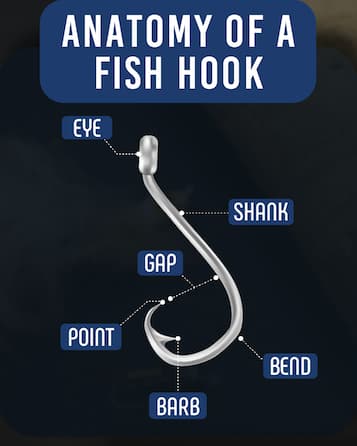
Eye
The eye of the fishing hook is the rounded part at the top of the hook where you tie on your fishing line, leader, or attach a swivel.
Most of the time this is a closed ‘loop’. The size of the eye is based on the size of the hook. The larger the eye, the larger size fishing line or terminal tackle you can attach to the hook.
Shank
The shank of a fishing hook refers to the ‘body’ of the hook between the eye and the point. This is usually straight, or slightly curved in most style fishing hooks. The size of the shank is directly related to the size and style of hook.
Gap
The gap of a fishing hook refers to the distance between the hook point and the shank. Some hooks are close gap, and others are wide gap. This distance is directly related to the size and style of the hook.
For example, many worm hooks are ‘extra-wide gap’, whereas most circle hooks are narrow gaps. More on that later…
Point
The point of the hook refers to the sharpest end of the hook, where your bait is attached, and what is used to pierce a fish and set the hook. There are numerous styles of points on fishing hooks such as needlepoint, spear point, trocar, hollow and knife edge.
The most important thing with hook points is to be sure they are sharp. I keep a hook sharpener in my tackle box at all times.
Always inspect your hook point after catching a fish or a snag. Even the smallest damage to the hook point can affect future hooksets.
Barb
The barb of the hook refers to the small piece of hook or metal directly below the point, that sticks out to prevent the hook from backing out. The barb is meant to keep baits on the hook and keep the hook set in the fish.
Some hooks are ‘barbless’ meaning they do not have a barb. These hooks are much easier to remove from a fish or bait, and generally less damaging than barbed hooks.
Many anglers ‘mash’ down their barbs, or fish with barbless hooks to reduce damage and stress on fish. This is especially true in the fly fishing community.
Bend
The bend refers to the portion of the shank that begins to curve between the eye and the point. The bend of a hook is directly related to the style and type of hook. Some hooks have a long shank and shallow bend. Others have a short shank and very long bend.
Following along so far?
The 10 Most Common Fishing Hooks
Okay, so when you look online or go to your local bait and tackle shop you are probably a bit overwhelmed at the hook section. There are usually hundreds of varieties of hooks in all different shapes, colors and sizes.
Don’t let that confuse you! The majority of the time this is just marketing ploys- trying to grab your attention on the best and brightest. When it comes to fishing, the basics matter.
Below are the 10 most common fishing hooks, that will work in 99% of all fishing scenarios.
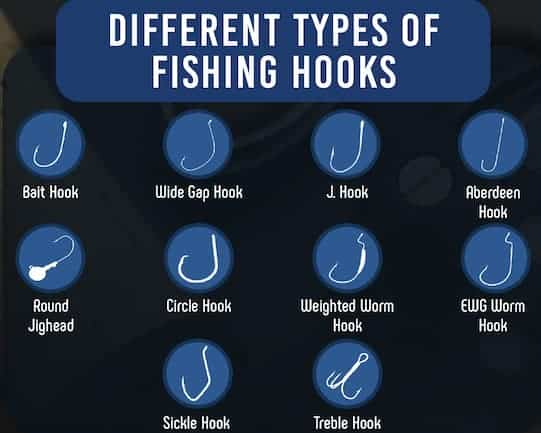
Bait Hook
Baitholder Hooks are easily identified by the barbs located on the shank. As the name suggests, baitholder hooks are primarily used for live or dead bait such as worms, crickets, clams, shrimp etc.
Bait hooks are common in both freshwater and saltwater fishing.
Wide Gap Hook
Wide Gap Hooks are primarily used in freshwater fishing when rigged with soft plastics such as worms, lizards and creature baits. The Wide gap allows for the soft plastic to compress, which means a better chance of a clean hookset.
J-Hook
The J-hook is what most people picture when they think of a ‘fishing hook’. Its shape resembles the letter ‘J’ and it can be made from a wide range of materials and is available in almost every size.
This J-hook is one of the most versatile and common fishing hooks used in freshwater fishing, saltwater fishing, and everything in between. It can be used with live bait, dead bait or artificial baits.
Many anglers get a variety pack of hooks to add to their tackle box so they are covered for any fishing scenario.
Aberdeen Hook
The Aberdeen Hook is a long shank-style J-hook primarily used in freshwater fishing. It features a long shank and a short bend that is very easy to remove, especially in fish that have small mouths such as bluegill or shellcracker.
Aberdeen hooks are primarily used for bait fishing, and very popular with panfish anglers.
Round Jighead
The round jighead is a J-hook with a weighted lead or tungsten piece around the eye and top of the shank. It is used to add extra weight to a hook, without having to use a split shot or additional weight.
Jigheads are available in many different styles, and very popular in both freshwater and saltwater fishing. Other jighead varieties include the football jighead, bullet jigheads, and shaky heads and many more.
Strike King Jig-Heads are very strong and come in a variety of shapes and sizes.

Circle Hook
The Circle hook is a type of bait hook with a unique curved point. This curved point is meant to reduce the chances of a fish swallowing the hook.
When a fish eats a bait with a circle hook and the line is set tight, the circle hook is pulled outward until the special curved point catches the corner of the fish’s mouth.
The circle hook design has proven to be very effective at reducing fish mortality and injury and decrease the number of ‘gut hooks’ (when a fish completely swallows the hook).
Circle hooks are very popular in both freshwater and saltwater fishing. I personally use circle hooks on all of my live bait fishing, from wild shiners to shrimp, croakers, etc. I love circle hooks!
See Also: Kahle Hooks vs Circle Hooks
Weighted Worm Hook
The weighted worm hook is basically an offset hook with a built-in weight along the shank. Similar to the jig-head, this all-in-one-piece construction adds additional weight for casting and action.
Weighted worms hooks are primarily used in freshwater, but may also be used in saltwater too. These hooks are commonly paired with worms, swimbaits, flukes, and other soft plastics.
EWG Worm Hook
EWG stands for “Extra Wide Gap” and is a type of offset worm hook with an oversized ‘gap (the area between the point and shank). This is primarily used when fishing large soft plastics such as worms, swimbaits, and even frogs in freshwater fishing, but may also be used in saltwater fishing as well.
Gamakatsu EWG Hooks are my favorite, and they haven’t let me down yet!

Sickle Hook
The Sickle hook is a type of hook that does not have the normal gradual bend in the shank, instead, it has a 45-degree angle bend that resembles a sickle. These hooks are primarily used in freshwater fishing with live bait.
In recent years Sickle hooks have become very popular in the Crappie fishing community especially when fishing with live minnows.
Treble Hook
A treble hook is three J-hooks formed together into one piece. These hooks have one eye at the top and are used to greatly increase the chances of a hookup or hook set.
Treble hooks are primarily used on artificial lures such as crankbaits, jerk baits, and topwater plugs. They may also be used in offshore fishing for Wahoo, Kingfish, and Mahi-Mahi.
Treble hooks can be harmful to fish and humans because they have 3 very sharp hooks each with their own barb, always exercise caution when using or removing treble hooks.
Also, check the local fishing regulations in your area, some areas prohibit the use of treble hooks for certain species.
Fishing Hooks Sizes
Fishing hooks are manufactured by many different popular tackle companies such as Mustad, Gamagatsu, Eagle Claw, Owner, etc.
There is not a ‘standard size’ that all manufacturers follow. Instead, hooks are loosely based on the same size and measuring system.
Think of it like T-shirts: If you buy a Large T-shirt from five different stores, they are not all going to be exactly the same, right? But, they will all be generally pretty close.
The same applies to hooks. Tackle companies all follow and use the same terminology, but sizes and variations exist.
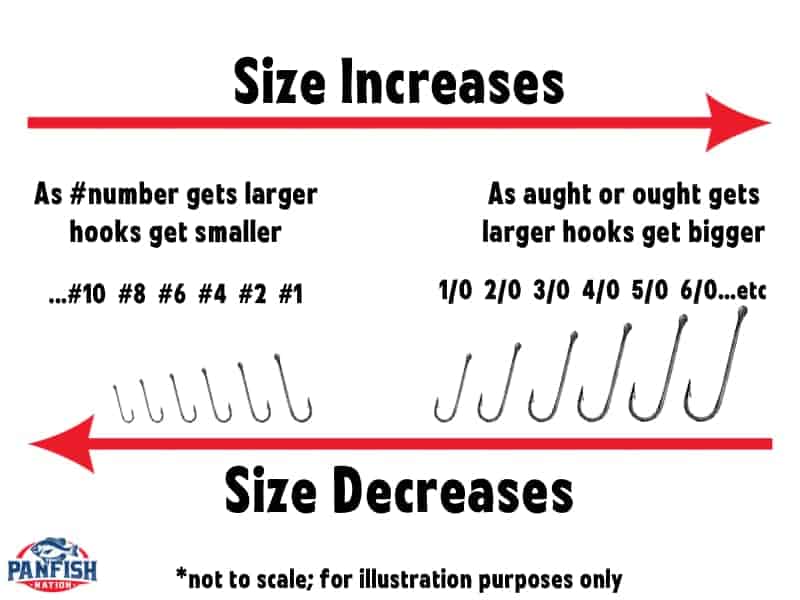
‘Aught’ or ‘Ought’ Hook Sizes
Hooks are generally classified by two measurement systems. The first is ‘aught’ or sometimes spelled ‘ought’ and this refers to the /0 often found after a number. For example, a ‘4/0’ hook would be a “Four ought hook”.
A 7/0 Hook would be referred to as a “Seven ought hook”. Make sense?
The smallest ought hook size would be a 1/0 or “one ought hook”. Once you get below a 1/0, the ‘ought’ terminology is no longer used. Then it becomes whole numbers.
This measurement system is typically used for larger-sized hooks associated with medium to large fish species. For more information see the Hook Selection Guide below on recommended hook sizes.
Other Hook Sizes
All other fishing hook sizes smaller than 1/0 are then measured by whole number only. For example a #1 or ‘number one hook’ or #5 ‘number five hook’ etc.
The tricky part here is that unlike the ought sizes where the larger the number, the larger the hook- now it becomes reversed; the larger the number the smaller the hook.
For example, hooks sizes from smallest to largest would be #10, #8, #6, #4, #2, #1, 1/0, 3/0, 5/0, 6/0 etc.
Sizes go well beyond what is shown in these charts! The smallest commercially available hook size is a #32 and the largest is 27/0!
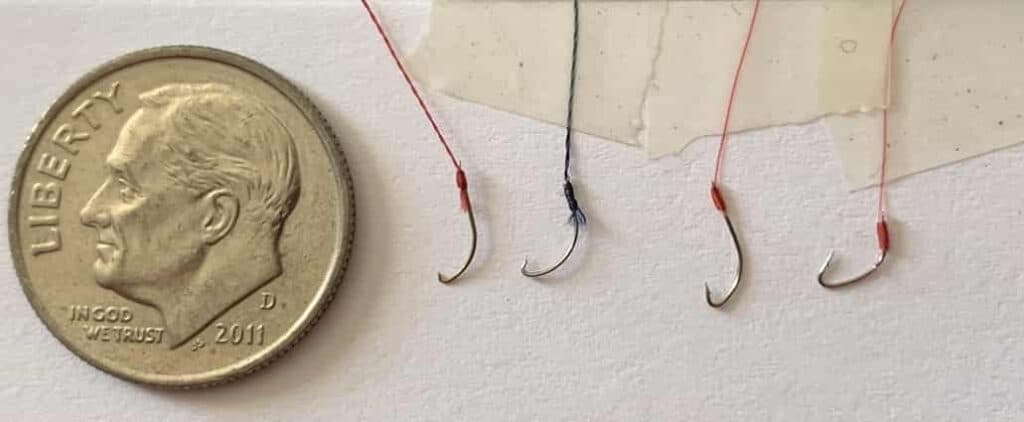
For example, the hooks above are extremely small around size #26-#30, and used for Microfishing.
Hook Size Chart
The hook size chart below encompasses everything I’ve covered so far. The anatomy of a fish hook, the different types of fishing hooks, and a size guide of fishing hooks.
Feel free to use this tool as a reference.
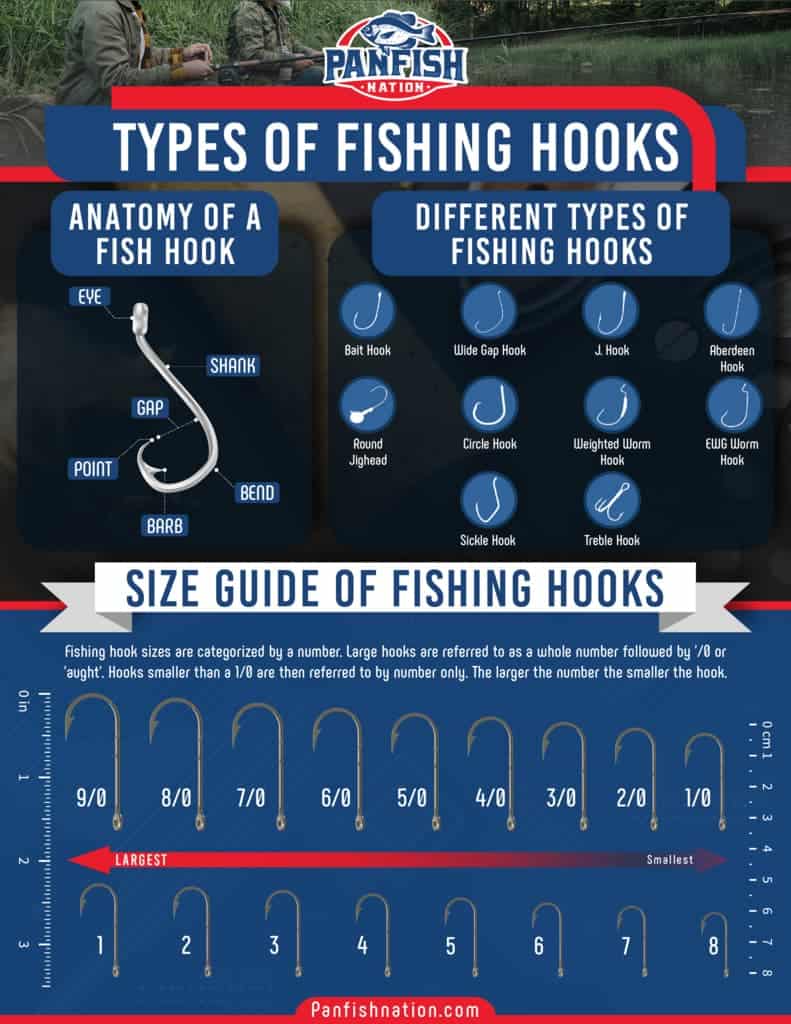
Download the Panfish Nation Hook Chart and Size Guide HERE!
Hook Selection Guide By Fish Species
NOTE: The following guide is meant to give you a general idea of the types of commonly used hooks and their sizes for each species of fish. It’s important to know that variability exists and every fisherman or angler has their preference.
For example, are you fishing for 100 pound Alligator Gar in Texas or 1 pound bullhead catfish in Florida? Obviously, the size and maybe the style of the hook will change with your answer.
Freshwater Fish Hook Selection Guide
| Fish Species | Hook Types | Hook Size Range |
| Panfish (sunfish, perch, etc) | Bait hook, J-hook, Aberdeen hook, Jighead, Sickle hook | #4 to #12 |
| White Bass | J-hook, Jighead | #1 to #4 |
| Tilapia | Bait Hook, J-hook, Aberdeen Hook, Jighead | #2 to #6 |
| Smallmouth Bass | J-hook, Jighead, Worm hook | 3/0, 2/0, 1/0, #1-#3 |
| Largemouth Bass | Wide Gap hook, J-hook, Jighead, Circle hook, Worm hook | 6/0-1/0 |
| Striped Bass | J-hook, Jighead, Circle hook, Worm hook | 8/0-1/0 |
| Catfish | Bait hook, J-hook, Circle Hook | 6/0-1/0 |
| Trout (rainbow, brown, broke, etc) | Bait hook, J-hook, Jighead, Barbless hook | #3 to #16 |
| Carp (buffalo, common, horse, etc) | Bait Hook, J-hook, Circle Hook | 5/0-1/0 |
| Alligator Gar | Bait Hook, J-hook, Circle Hook | 8/0-6/0 |
| Other Gar (longnose, spotted, etc) | Bait hook, J-hook, Jighead, Circle Hook | 4/0-1/0 |
| Peacock Bass | Bait Hook, Wide Gap Hook, J-hook, Jighead, Worm Hook | 4/0-1/0, #1 to #3 |
| Exotic Panfish (Oscar, Cichlid, etc) | Bait Hook, J-hook, Aberdeen Hook, Jighead, Sickle Hook | #3 to #8 |
| Walleye | Bait Hook, J-hook, Jighead, Worm Hook | 2/0, 1/0, #1 to #3 |
| Northern Pike | Bait Hook, Wide Gap Hook, J-hook, Jighead, Worm Hook | 4/0-1/0 |
| Muskellunge | Bait Hook, Jighead, Circle Hook, Worm Hook | 7/0-2/0 |
| Sturgeon | Circle Hook, J-hook | 9/0-5/0 |
| King Salmon | Bait hook, J-hook, Jighead, CIrcle Hook | 6/0-3/0 |
| Othe Salmon (Coho, Sockeye, etc) | Bait hook, J-hook, Jighead, CIrcle Hook | 4/0-1/0, #1 to #3 |
| Shad | Bait hook, J-hook, Aberdeen Hook | #2 to #6 |
| Herring | Bait hook, J-hook, Aberdeen Hook | #4 to #8 |
| Paddlefish | Bait Hook, J-hook, Circle Hook | 8/0-1/0 |
| Suckers (Razorback, | Bait hook, J-hook, Aberdeen Hook | #4 to #10 |
| Whitefish | Bait hook, J-hook, Aberdeen Hook, Jighead | #2 to #8 |
| Burbot | Bait hook, J-hook, Aberdeen Hook, Circle Hook | 3/0-1/0, #1 to #4 |
Saltwater Fish Hook Selection Guide
| Fish Species | Hook Types | Hook Size Range |
| Croaker | Bait Hook, J-jook, Aberdeen Hook, Jighead | #1 to #8 |
| Weakfish | Bait Hook, J-hook, Jighead, Circle Hook | #1 to #4 |
| Small Snapper (mangrove, yellowtail, lane, etc) | Bait Hook, J-hook, Jighead, Circle Hook | 3/0-1/0, #1-#4 |
| Spotted Sea Trout | J-hook, Jighead, Circle Hook, Worm Hook | 3/0 to 1/0 |
| Flounder | Bait Hook, J-hook, Jighead, Circle Hook | 3/0 to 1/0 |
| Pompano | Bait Hook, J-hook, Aberdeen Hook, Jighead, Circle Hook, Sickle Hook | 2/0, 1/0 #1-#4 |
| Black Seabass | Bait Hook, J-hook, Jighead, Circle Hook | 1/0, #1 to #5 |
| Spanish Mackeral | Bait Hook, J-hook, Jighead, Worm Hook | 2/0, 1/0, #1 |
| Kingfish | Bait Hook, J-hook, Circle Hook | 6/0-3/0 |
| Tilefish | Bait Hook, J-hook, Aberdeen Hook, Jighead, Circle Hook | 2/0, 1/0, #1-#3 |
| Dorado (Mahi-Mahi) | Bait Hook, J-hook, Jighead | 6/0-1/0 |
| Sailfish | Bait Hook, J-hook | 7/0-3/0 |
| Marlin (Black, Blue, White etc) | Bait Hook, J-hook | 12/0-6/0 |
| Large Snapper (red, mutton, cubera etc) | Bait Hook, J-hook, Circle Hook, Jighead | 8/0-4/0 |
| Grouper (black, red, gag, warsaw etc) | Bait Hook, J-hook, Circle Hook, Jighead | 9/0-5/0 |
| Redfish | Bait Hook, Wide Gap Hook, J-hook, Jighead, Circle Hook, Worm Hook | 6/0-1/0 |
| Black Drum | Bait Hook, J-hook, Jighead, Circle Hook | 5/0-1/0 |
| Cobia | Bait Hook, J-hook, Jighead, CIrcle Hook | 9/0-5/0 |
| Tarpon | Bait Hook, J-hook, Jighead, CIrcle Hook, Worm Hook | 8/0-4/0 |
| Bonefish | Bait Hook, J-hook, Aberdeen Hook, Barbless Hook, Jighead | 1/0, #1 to #6 |
| Swordfish | Circle Hook | 12/0-8/0 |
| Shark | Circle Hook, J-hook | 12/0-4/0 |
| Yellowfin Tuna | Bait Hook, J-hook, Circle Hook | 3/0-1/0 |
| Bluefin Tuna | Bait Hook, J-hook, Circle Hook | 10/0-8/0 |
| Jack Crevalle | Bait Hook, Wide Gap Hook, J-hook, Jighead, Circle Hook, Worm Hook | 6/0-2/0 |
| Permit | Bait Hook, J-hook, Circle Hook | 5/0-1/0 |
| Roosterfish | Bait Hook, J-hook, Circle Hook | 7/0-4/0 |
| Giant Trevally | Bait Hook, J-hook, Circle Hook | 8/0-5/0 |
| Bluefish | Bait Hook, J-hook, Jighead, Circle Hook, Worm Hook | 4/0-1/0 |
| Halibut | Circle Hook | 16/0-8/0 |
| Wahoo | Bait Hook, J-hook, Circle Hook | 8/0-5/0 |
| Barracuda | Bait Hook, J-hook, Circle Hook, Jighead | 8/0-3/0 |
| Tripletail | Bait Hook, J-hook, Circle Hook, Jighead | 3/0-1/0 |
| Barramundi | Bait Hook, Wide Gap Hook, J-hook, Jighead, Circle Hook, Worm Hook | 3/0-1/0 |
| Snook | Bait Hook, Wide Gap Hook, J-hook, Jighead, Circle Hook, Worm Hook | 6/0-3/0 |
Frequently Asked Questions About Fishing Hooks
How many types of fishing hooks are there?
There are dozens of different types of fishing hooks available today. Tackle manufacturers have designed special hooks for every style of fishing. Additionally, most hook types are available in a wide range of sizes and materials, making the options seem endless.
How do you know what size fishing hook to use?
Choosing the right size hook comes with experience, and is usually dependent on the size of the bait and the size of your targeted species. Take a look at our hook selection guide for recommendations.
What is a snelled fishing hook
A snelled hook is a technique of securing your fishing line or leader to the shank of the hook instead of to the eye of the hook. It was used before fish hooks were manufactured with an eye or opening. Many anglers still use snell hooks today.
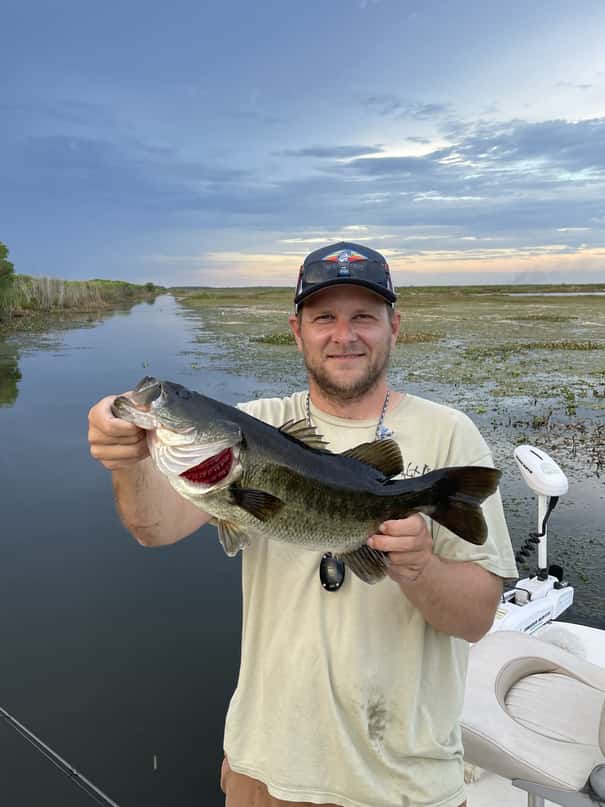
What is the best knot for a fishing hook
If you really want to start a debate, ask five fishermen what’s the best knot, you will get a different answer from each of them! The best knot is one that you can tie correctly, for the fishing application you are using. The Palomar knot, The Uni-knot, and the Clinch knot are the most popular knots used today in both freshwater and saltwater fishing.
Will fish bite if they see the hook?
Some species of fish are known to be ‘line shy’ or ‘tackle shy’ and reluctant to bite if they see the hook. Fish that are heavily pressured or eat very small baits may not bite if they see the hook.
Do Fish learn to avoid hooks?
Some studies suggest that fish behavior can change after repeated catches or angling pressure. This is especially true with artificial baits and lures. “Catchability to spinner fishing decreased to very low levels after about half of the population had been caught in this way. Catchability to live bait fishing remained unaffected both by intensive spinner and live bait fishing.”
Source: https://onlinelibrary.wiley.com/doi/10.1111/j.1095-8649.1970.tb03268.x
Do fish die after being hooked?
When hooks are used properly, fish should not die after being hooked. Most fishing hooks are designed to be removed if you wish to catch and release. However, mortality does occur but it is not significant.
For more information on how you can reduce catch and release mortality, click here.
Why do people fish with barbless hooks?
Barbless hooks are used to reduce the damage inflicted by traditional fishing hooks. A barbless hook is much easier to remove, and less likely to be swallowed or ‘gut hooked’. This means getting your catch back into the water quicker, for a healthy release.
How do you remove a fish hook?
Removing a fishhook takes practice and an understanding of how a fish hook works. Use a tool such as forceps, fishing pliers or a hook remover.
Carefully handle the fish and ‘reverse’ the hook out by turning the eye toward the point.
What to do if you cant remove hook from fish?
If the fish has swallowed the hook, and you cannot remove the hook it’s best to cut the line as close to the fish mouth as possible. In many cases, the fish hook will pass through or rust out.
Attempting to remove a gut hooked or swallowed hook can often inflict fatal damage to a fish. That is why it’s so important to use the correct hook size, tend to your line, and handle your catch with care (wet your hands, minimize time out of the water, etc).
If you cannot remove the hook and the fish may die, consider keeping the fish as long as your following the fishing regulations in your area.
Final Thoughts
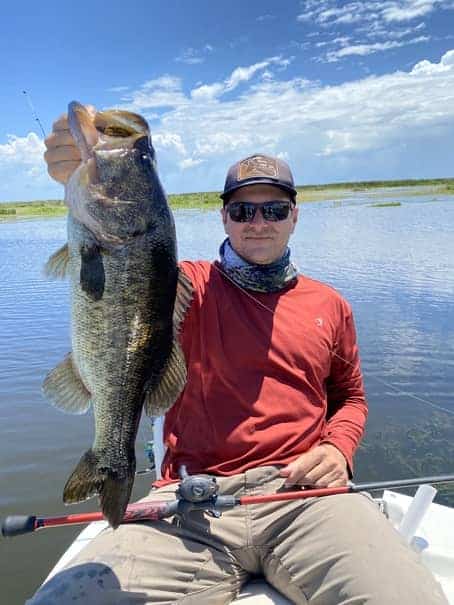
Ok so let’s recap: Fishing tackle manufacturers all use similar terminology to describe parts and fishing hook sizes, but it’s not standardized industry-wide.
The more you fish, the more you will begin to see the subtle differences in fishing hooks and the pros and cons of each.
Use this information, and the hooks available to find what works best for YOU and YOUR fishing style. That’s what matters most!
Choosing the correct fishing hook size and type takes a little bit of practice and education, but don’t let that keep you from enjoying time on the water with family and friends.
Thanks for reading and I hope you catch ‘the big one’ the next time you go fishing!
See Also: Understanding The Different Types of Fishing Reels…with Pros and Cons of Each
If you haven’t guessed yet, I love fishing and everything about it!
To learn more about why I started Panfish Nation, visit the About page and follow along on Social Media:


Download a copy of my FREE Lure Color Selection Chart & Knot Guide!
Stay up to date with fishing reports, tackle reviews, industry news, and much more! We respect your privacy, unsubscribe at any time.
Like this post? Save it on Pinterest.
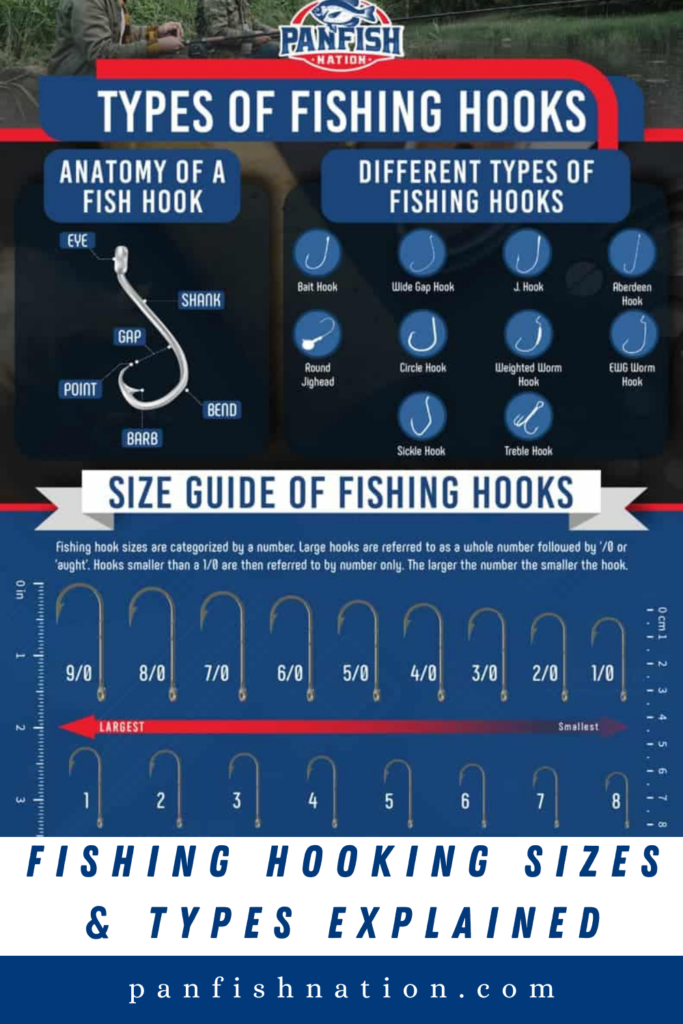
- Sauger vs Walleye: Learn These Differences and Catch More!
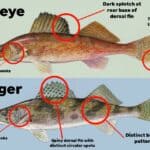
- How To Hold A Bluegill: Tips and Best Practices
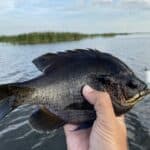
- How To Catch Wild Shiners For Bait (Step By Step W/Pics)
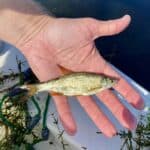
- Crazy Facts About the World Record Crappie

- What Size Hooks for Smallmouth Bass? Quick Guide

- Large and in Charge-Mouth: 10 of the Best Bass Lures of All Time (And Where to Buy Them)

